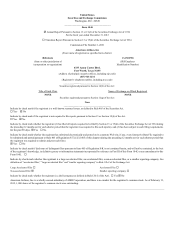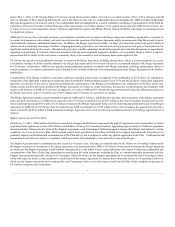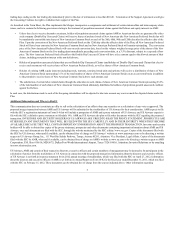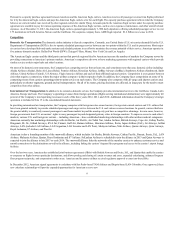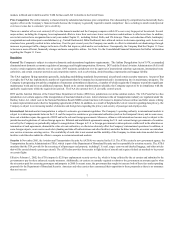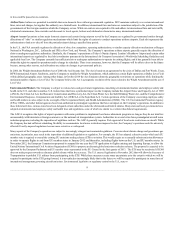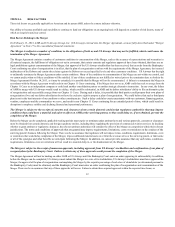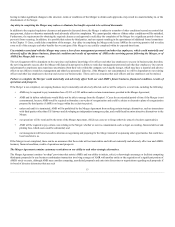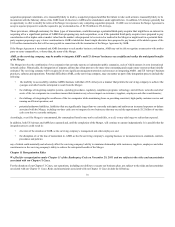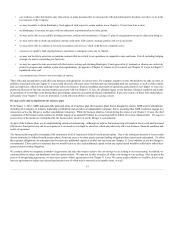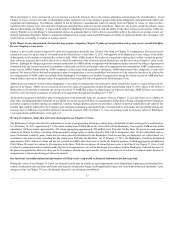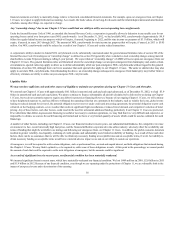American Airlines 2012 Annual Report Download - page 8
Download and view the complete annual report
Please find page 8 of the 2012 American Airlines annual report below. You can navigate through the pages in the report by either clicking on the pages listed below, or by using the keyword search tool below to find specific information within the annual report.
in fees could be passed on to customers.
Airline Fares Airlines are permitted to establish their own domestic fares without governmental regulation. DOT maintains authority over certain international
fares, rates and charges, but applies this authority on a limited basis. In addition, international fares and rates are sometimes subject to the jurisdiction of the
governments of the foreign countries which the Company serves. While air carriers are required to file and adhere to international fare and rate tariffs,
substantial commissions, fare overrides and discounts to travel agents, brokers and wholesalers characterize many international markets.
Airport Access Operations at four major domestic airports and certain foreign airports served by the Company are regulated by governmental entities through
allocations of “slots” or similar regulatory mechanisms which limit the rights of carriers to conduct operations at those airports. Each slot represents the
authorization to land at or take off from the particular airport during a specified time period.
In the U.S., the FAA currently regulates the allocation of slots, slot exemptions, operating authorizations, or similar capacity allocation mechanisms at Reagan
National in Washington, D.C., LaGuardia and JFK in New York, and Newark. The Company’s operations at these airports generally require the allocation of
slots or analogous regulatory authorities. Similarly, the Company’s operations at Tokyo’s Narita Airport, London’s Heathrow Airport and certain other
international airports are regulated by local slot coordinators pursuant to the International Air Transport Association’s Worldwide Scheduling Guidelines and
applicable local law. The Company currently has sufficient slots or analogous authorizations to operate its existing flights, and it has generally been able to
obtain the rights to expand its operations and to change its schedules. There is no assurance, however, that the Company will be able to do so in the future
because, among other reasons, such allocations are subject to changes in governmental policies.
In 2006, the Wright Amendment Reform Act of 2006 (the Act) became law. The Act is based on an agreement by the cities of Dallas and Fort Worth, Texas,
DFW International Airport, Southwest, and the Company to modify the Wright Amendment, which authorizes certain flight operations at Dallas Love Field
within defined geographic areas. Among other things, in October 2014 the Act eliminates domestic geographic restrictions on operations while limiting the
maximum number of gates at Love Field. The Company believes the Act is a pragmatic resolution of the issues related to the Wright Amendment and the use of
Love Field.
Environmental Matters The Company is subject to various laws and government regulations concerning environmental matters and employee safety and
health in the U.S. and other countries. U.S. federal laws that have a particular impact on the Company include the Airport Noise and Capacity Act of 1990
(ANCA), the Clean Air Act, the Resource Conservation and Recovery Act, the Clean Water Act, the Safe Drinking Water Act, and the Comprehensive
Environmental Response, Compensation and Liability Act (CERCLA or the Superfund Act). Certain operations of the Company concerning employee safety
and health matters are also subject to the oversight of the Occupational Safety and Health Administration (OSHA). The U.S. Environmental Protection Agency
(EPA), OSHA, and other federal agencies have been authorized to promulgate regulations that have an impact on the Company’s operations. In addition to
these federal activities, various states have been delegated certain authorities under the aforementioned federal statutes. Many state and local governments have
adopted environmental and employee safety and health laws and regulations, some of which are similar to or stricter than federal requirements.
The ANCA recognizes the rights of airport operators with noise problems to implement local noise abatement programs so long as they do not interfere
unreasonably with interstate or foreign commerce or the national air transportation system. Authorities in several cities have promulgated aircraft noise
reduction programs, including the imposition of nighttime curfews. The ANCA generally requires FAA approval of local noise restrictions on aircraft. While
the Company has had sufficient scheduling flexibility to accommodate local noise restrictions imposed to date, the Company’s operations could be adversely
affected if locally-imposed regulations become more restrictive or widespread.
Many aspects of the Company's operations are subject to increasingly stringent environmental regulations. Concerns about climate change and greenhouse gas
emissions, in particular, may result in the imposition of additional legislation or regulation. For example, the EU has adopted a directive under which each EU
member state is required to extend the existing EU emissions trading scheme (ETS) to aviation. This would require us to annually submit emission allowances
in order to operate flights to and from EU member states in January 2012 and thereafter, including flights between the U.S. and EU member states. In
November 2012, the European Commission proposed to suspend for one year the ETS' application to flights entering and departing Europe, to allow the
United Nations' International Civil Aviation Organization (ICAO) to propose an alternate global emissions reduction scheme. The proposal is expected to be
approved by the European Parliament and EU member states represented in the EU Council in the first quarter of 2013. The ETS may be reactivated if ICAO
does not make progress towards an alternate global scheme within the next year. The U.S. enacted legislation in November 2012 that will allow the Secretary of
Transportation to prohibit U.S. airlines from participating in the ETS. While these measures create some uncertainty as to the extent to which we will be
required to participate in the ETS going forward, it is nevertheless increasingly likely that in the future we will be required to participate in some form of
international arrangement governing aircraft emissions. Environmental legislative or regulatory action by the U.S., state or
8

